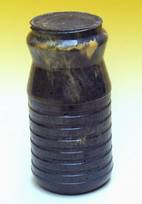Geopolymers are chains or networks of mineral molecules linked with co-valent bonds. They have following basic characteristics:
a) Nature of the hardened material:
- X-ray amorphous at ambient and medium temperatures
- X-ray crystalline at temperatures > 500°C
b) Synthesis Routes:
- alkaline medium (Na, K, Ca) hydroxides and alkali-silicates yielding poly(silicates) – poly(siloxo) type or poly(silico-aluminates) – poly(sialate) type
- acidic medium (Phosphoric acid) yielding poly(phospho-siloxo) and poly(alumino-phospho) types
As an example, one of the geopolymeric precursors, MK-750 (metakaolin) with its alumoxyl group –Si-O-Al=O, reacts in both systems, alkaline and acidic. Same for siloxo-based and organo-siloxo-based geopolymeric species that also react in both alkaline and acidic medium.
Geopolymer Terminology
In the late 1970’s, Joseph Davidovits, the inventor and developer of geopolymerization, coined the term “geopolymer” to classify the newly discovered geosynthesis that produces inorganic polymeric materials now used for a number of industrial applications. He also set a logical scientific terminology based on different chemical units, essentially for silicate and aluminosilicate materials, classified according to the Si:Al atomic ratio:
Si:Al = 0, siloxo
Si:Al = 1, sialate (acronym for silicon-oxo-aluminate of Na, K, Ca, Li)
Si:Al = 2, sialate-siloxo
Si:Al = 3, sialate-disiloxo
Si:Al > 3, sialate link.
This terminology was presented to the scientific community at a IUPAC conference in 1976. See for details in the Library the paper Milestone Paper IUPAC-76
In the introduction of his book on alkali-geopolymer cement, the alkali-cement scientist John Provis, challenged the use of the word ‘sialate’ arguing that “…the term ‘sialate’ was already in use (since the 1950s) to describe any of the salts of organic sialic acid …” He simply forgot to mention that long before 1950 geology has been using extensively the term ‘sialic’, for example in ‘sialic metamorphic rocks‘, or ‘the oceanic crust is mostly basaltic and the continental crust is mostly sialic, meaning the rocks, such as granite, contain high amounts of aluminum and silica‘. Not to forget the fact that fly ashes were and still are commonly classified into three entities: calcic-, ferric- and sialic-groups; the sialic component results from the %weight of (SiO2 + Al2O3 + TiO2). There exists another example, namely the well known term ‘SIALON’, a specialist class of high temperature refractory materials, acronym of silicon-aluminum-oxo-nitride, i.e. a scientific logical terminology. The geopolymeric ‘sialate‘ term proceeds from the same scientific logic (it is the acronym of silicon-oxo-aluminate), in contrast with the organic molecule ‘sialic acid’ that was derived from an ancient Greek word meaning ‘saliva’, with no scientific association. In fact, for our geopolymer molecules we write poly(sialate) / polysialate or poly(sialate-siloxo), a terminology never used in biochemistry. We shall therefore keep our terminology, use it and promote it without any restriction.
Geopolymers comprise following molecular units (or chemical groups):
-Si-O-Si-O- siloxo, poly(siloxo)
-Si-O-Al-O- sialate, poly(sialate)
-Si-O-Al-O-Si-O- sialate-siloxo, poly(sialate-siloxo)
-Si-O-Al-O-Si-O-Si-O- sialate-disiloxo, poly(sialate-disiloxo)
-P-O-P-O- phosphate, poly(phosphate)
-P-O-Si-O-P-O- phospho-siloxo, poly(phospho-siloxo)
-P-O-Si-O-Al-O-P-O- phospho-sialate, poly(phospho-sialate)
-(R)-Si-O-Si-O-(R) organo-siloxo, poly-silicone
-Al-O-P-O- alumino-phospho, poly(alumino-phospho)
-Fe-O-Si-O-Al-O-Si-O- ferro-sialate, poly(ferro-sialate)
Geopolymers are presently developed and applied in 10 main classes of materials:
- Waterglass-based geopolymer, poly(siloxonate), soluble silicate, Si:Al=1:0
- Kaolinite / Hydrosodalite-based geopolymer, poly(sialate) Si:Al=1:1
- Metakaolin MK-750-based geopolymer, poly(sialate-siloxo) Si:Al=2:1
- Calcium-based geopolymer, (Ca, K, Na)-sialate, Si:Al=1, 2, 3
- Rock-based geopolymer, poly(sialate-multisiloxo) 1< Si:Al<5
- Silica-based geopolymer, sialate link and siloxo link in poly(siloxonate) Si:Al>5
- Fly ash-based geopolymer
- Ferro-sialate-based geopolymer
- Phosphate-based geopolymer, AlPO4-based geopolymer
- Organic-mineral geopolymer


